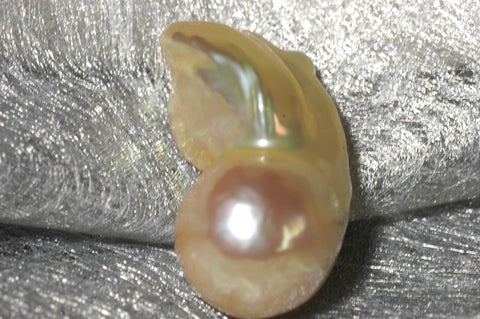The most celebrated pearl product around the turn of the century, bead-nucleated Chinese freshwater pearls not only reach impressive size, but introduce some entirely unfamiliar new shapes. Their similarity to baroque pearls from ocean cultivation (nearly all of which have bead nuclei) is rarely close, since mussels have different growth patterns. At least two fundamentally different methods of freshwater pearl cultivation utilizing round bead nuclei are in use.

Most of the Chinese bead-nucleated freshwater pearls widely available since 2003 belong to a new category. We call them flame type, having learned that some of our suppliers use Chinese words such as ya`n zhu- 炎珠 meaning flame pearls. Such shapes result from nucleating existing pearl sacs in the mantle. Because the sac does not grow around the bead, there is not a good fit. Also, the incision made in the pearl sac to harvest seldom heals neatly. Instead, the cut edges tend to grow away from an inserted nucleus, and this predisposes the pearls to have considerably long "tails", that is, the typical flame shape.
Such pearls were not cultivated in Japan, where in-body nucleation technology was available, and could be adapted to freshwater mussels. This is the only kind of fw pearl farming still ongoing in Japan, albeit on a vestigial scale. For details, see: Japan Kasumi-ga-Ura pearls and in-body nucleated pearls. Flame-type Cfw pearls come from a production stream that shifts the strategy of mantle cultivation away from maximizing number of pearls to maximizing size. As described in 2007 by Doug Fiske (GIA) and Jeremy Sheppard, fewer pearl sacs are grafted per mussel, and preference is given to the ends, which are less likely than the middle to be subject to pressure from growth. During the first harvest of non-nucleated pearls, the operator makes a decision based on the harvested pearl's shape, for each individual pearl sac. If it suggests enough depth is available, insert a bead nucleus to make a flame pearl. If it is large but flat insert a flat shell nucleus to make a coin pearl. Sometimes insert a reject pearl, which makes a rather flat pearl with a distinctive shape. Or insert nothing, and a non-nucleated second harvest pearl, commonly called Cfw keshi, will grow in that pearl sac. Not surprisingly, strands have appeared in which all of these types of pearls are mixed.
As in-body nucleation comes within reach of more cultivators in China, and holds out hope for eventually competing with round southsea pearls from tropical Pinctada shells, it is likely that flame-type bead nucleation will decrease. Meanwhile, large non-nucleated and flame-type China freshwater pearls are appearing, often without introduction, in multi-colored baroque southsea pearl strands. The world of odd-ball pearls is certainly richer for the appearance of flame pearls.




Leave a comment